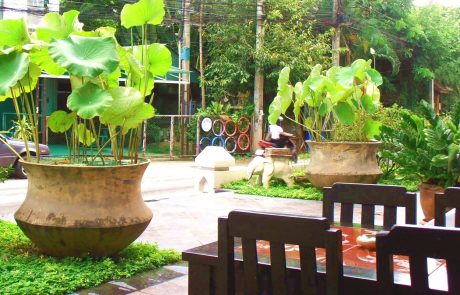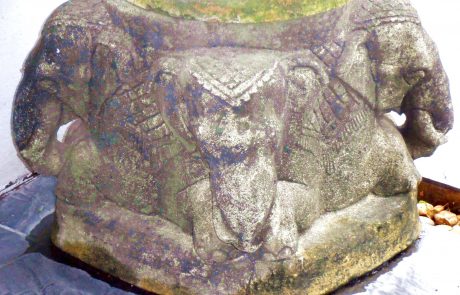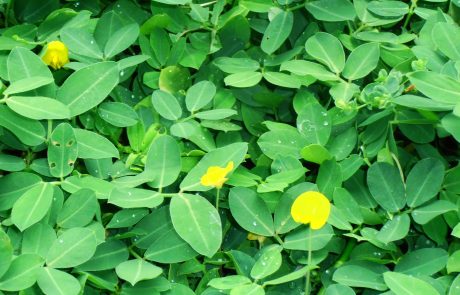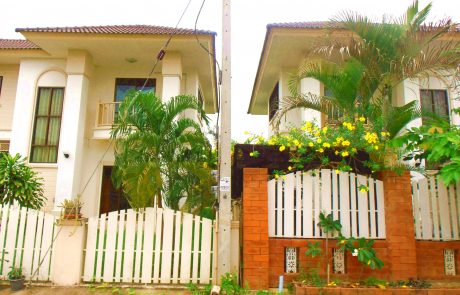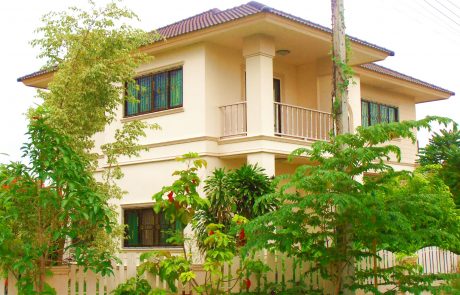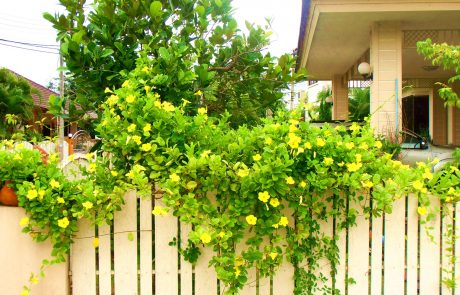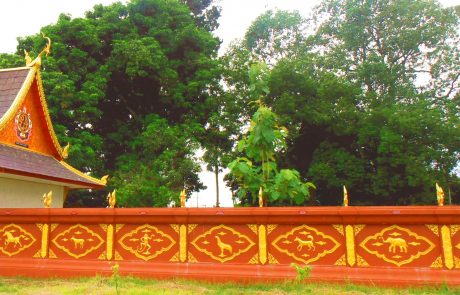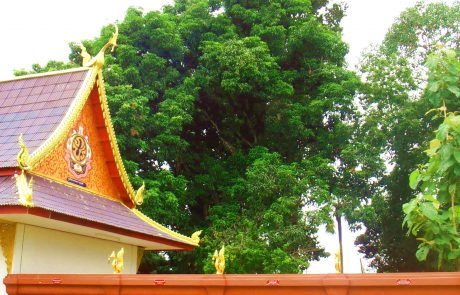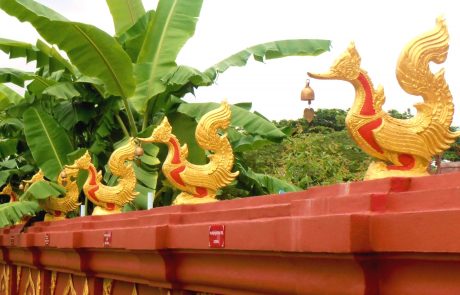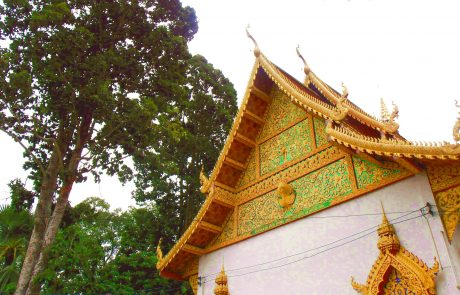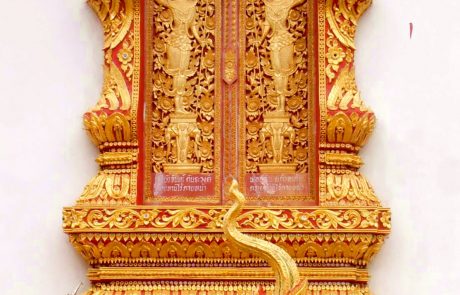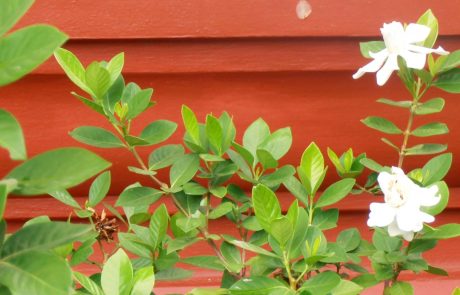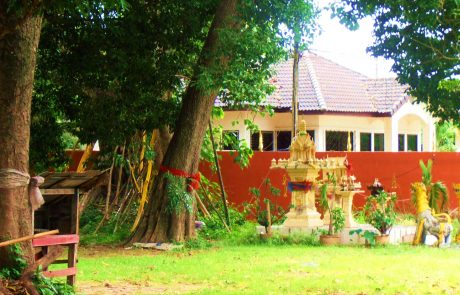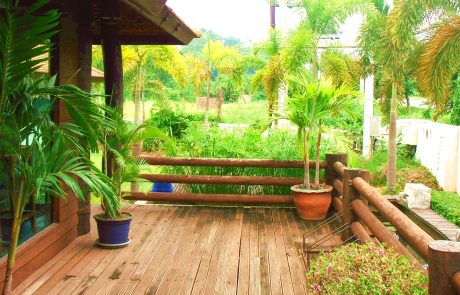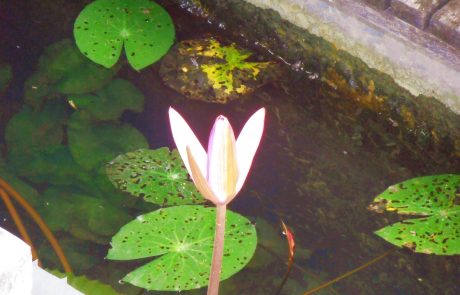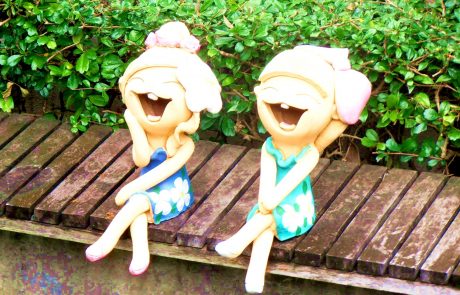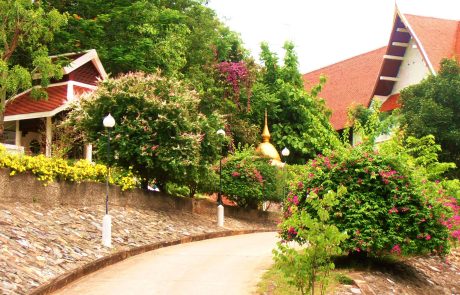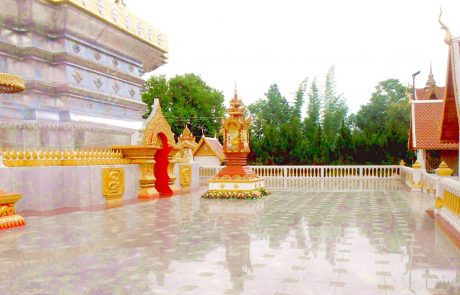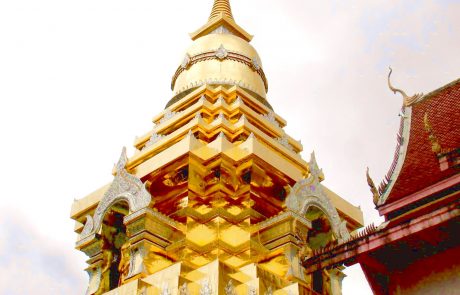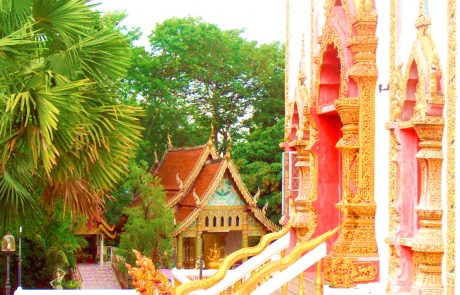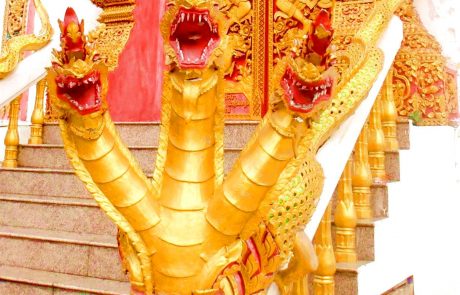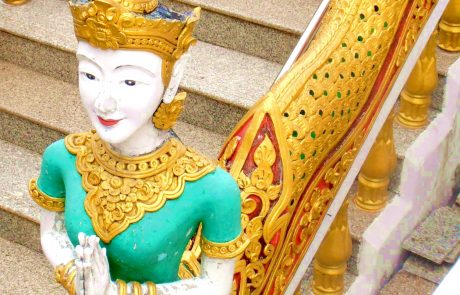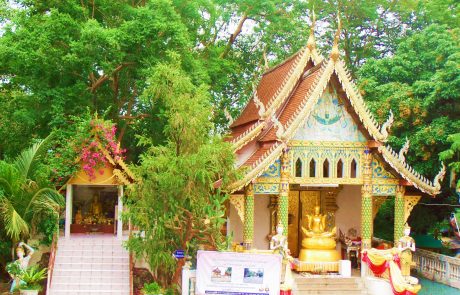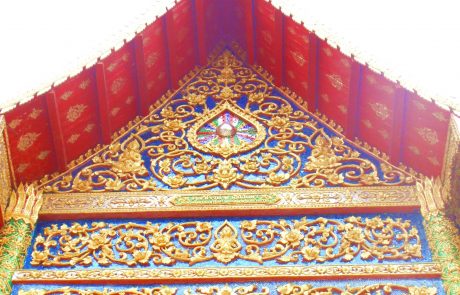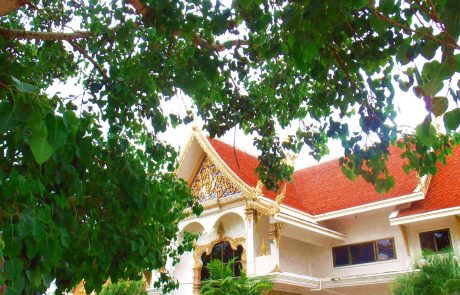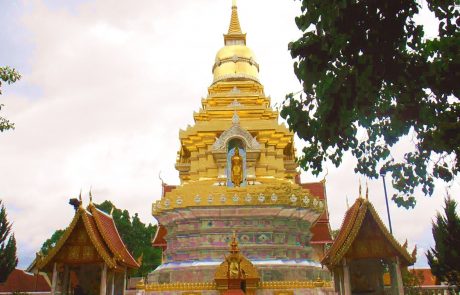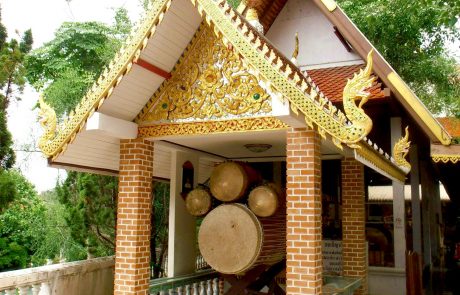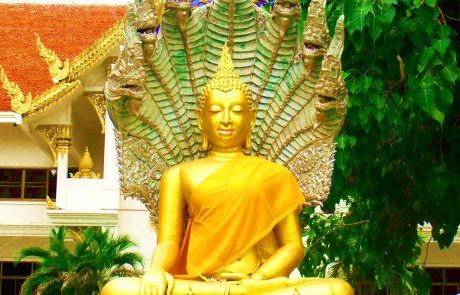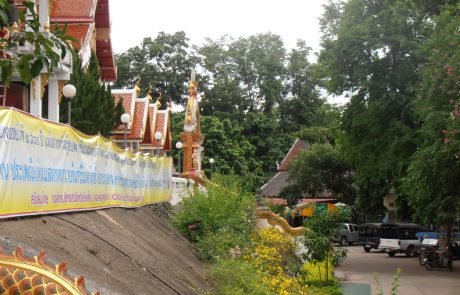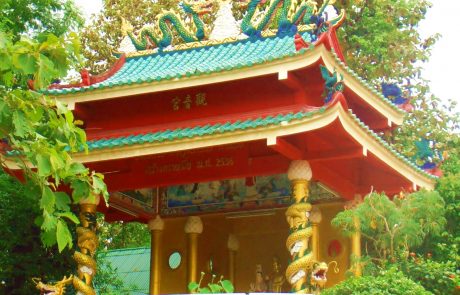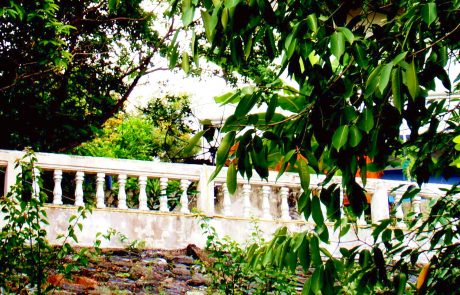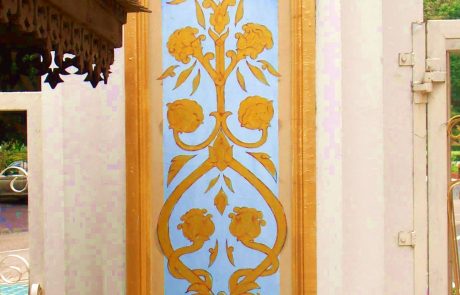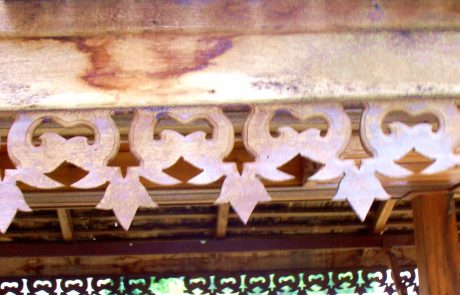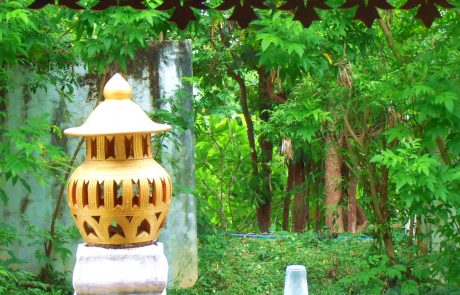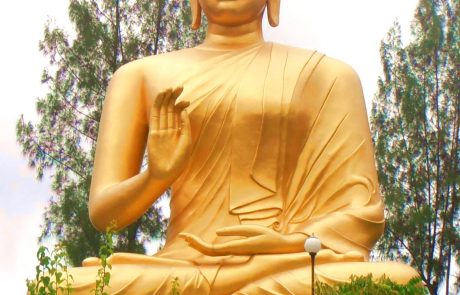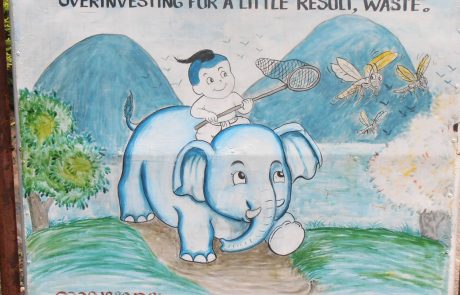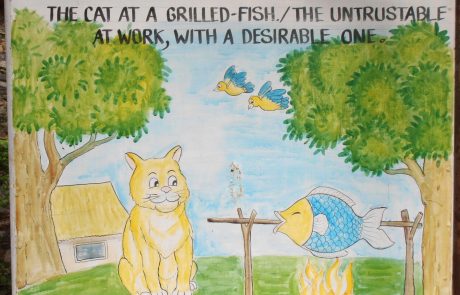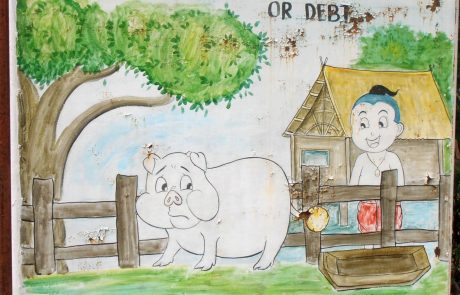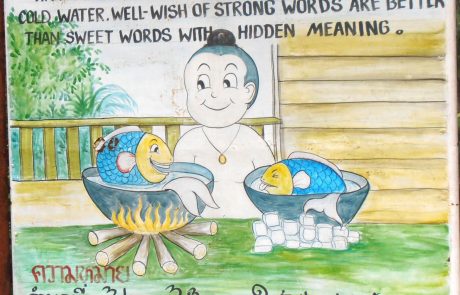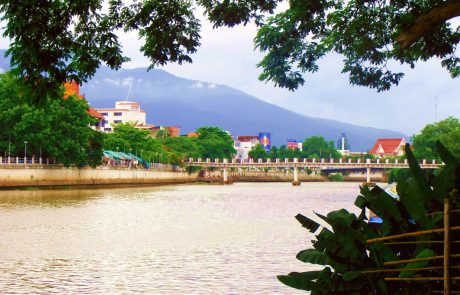February 2020
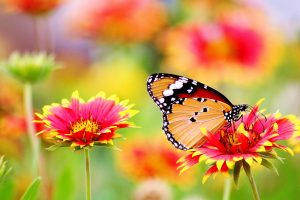 Looking through some pics of a stay in Chiang Mai I made a few years ago brought me face to face with a set of photos I took on a day trip to Doi Saket, about 20km (12 miles) northeast of Chiang Mai. I was the passenger on my friend’s motorbike, as I was so often wont to be. Hanging on to the back of a motorbike while going down the highway is not particularly pleasant, I will own it, but the sights the day brought made the incommodiousness of the means of transport a matter supremely secondary. The day remains vivid in my memory, especially my wanderings in the temple complex of Doi Saket. The pics will make clear why the memories remain so vivid, I hope.
Looking through some pics of a stay in Chiang Mai I made a few years ago brought me face to face with a set of photos I took on a day trip to Doi Saket, about 20km (12 miles) northeast of Chiang Mai. I was the passenger on my friend’s motorbike, as I was so often wont to be. Hanging on to the back of a motorbike while going down the highway is not particularly pleasant, I will own it, but the sights the day brought made the incommodiousness of the means of transport a matter supremely secondary. The day remains vivid in my memory, especially my wanderings in the temple complex of Doi Saket. The pics will make clear why the memories remain so vivid, I hope.
The day started off with a coffee in the Nimmamhaemin area, the trendy, boutiquey area of Chiang Mai in the west part of town near the foot of Doi Suthep mountain. I stayed (as usual) in a hotel near the Kad Suan Kaew mall within easy walking distance of Nimmanhaemin. So off I trundled in the morning to my favorite cafe for a cappuccino before my friend turned up and we hit the road.
It’s axiomatic that if I’m making a day trip somewhere the skies will cloud over and put my photos into a dinge. I did the best I could given the circumstances, but some patience — nay, forebearance — will be required of the reader. Mea culpa, mea maxima culpa.
The cafe in question was my favorite not because of the quality of the coffee, which as it happened was perfectly good, but rather because of the ambience of the place. Thais have a special gift for rendering any space, no matter how large or small, aesthetically pleasing and chock full of arresting details. It must be genetic, that’s the only explanation I can find readily to hand. When we Americans configure such spaces they turn out to be simple, functional, clean (usually) and standardized. Perfectly good for their purpose, but hardly something to spark surprise and certainly unlikely to create any especially memorable impression. My favorite cafe in Nimmanhaemin is a place I would frequent even if they sold no coffee. The outside seating is arranged on either side of a covered concrete channel with water flowing through it, providing the sense of coolness flowing water brings along with the soothing sounds of its gurgle as it flows. There are flowers in pots on the ground and hanging from the ceiling in whatever direction you look. In the pics you can see the enormous clay planters that frame the entrance. In another part of the entrance garden is a plant stand with the base you see in the second pic, a wonderfully sculptural rendering of elephant heads. On the floor of the tiny garden space spreads the wonderful ground cover in the third pic, a plant that could not be more handsome either in its foliage or its flowers. Add to all that a comfortable chair and a cappuccino and voilà!, I’m as happy as a clam for a good long while.
My Thai friend with the motorbike doesn’t drink coffee (and finds my addiction mildly reprehensible LOL) so as soon as I finished my cappuccino we hit the road. He’s a native of Chiang Mai and never goes from one place to another following the same route. We zig-zag through back streets I’ve never seen before and will never see again as we head from Point A to Point B. He had been asked by a friend to have a look at a house in a development outside town on the way to Doi Saket, and since I was along for the ride I had my first tour of a modern Thai housing development. Here are the pics:
It wasn’t a bad place, but I found myself reacting as though I had been taken to an American housing development and found things coming up a bit short. Yes, it followed the usual pattern one expects of a housing development, but my American eyes found red flags popping up right and left. Why were the houses squooshed so tightly together, so that you could reach over your balcony and hand that neighborly cup of sugar to your needy neighbor without bothering to go next door? Why were there no sidewalks? If somebody comes to visit and needs to park a car, do they have to do it somewhere outside the development and walk in? It’s clear nobody is going to park in front of any house in this development without blocking traffic. The house my friend had been asked to inspect had stood empty for some time and the garden had gone completely feral, as you see in the last pic. No covenants here, thank you very much. The most surprising thing of all: the prices. Hotel accommodation in Chiang Mai is to be had for a song and sixpence. These houses out in the middle of the rice fields, squooshed together and without any sidewalks or parking, had what seemed to me far too steep a pricetag. As the foreigner, however, it was incumbent on me to keep my mouth shut, which is exactly what I did.
The route from the housing development to Doi Saket took us on back roads I could never hope either to name or to find on a map. Along the way I spotted a temple out in the boondocks, one of those apparitions in the Thai countryside that stop me dead in my tracks with wonderment. How did this temple come to be built in this out of the way place? It wasn’t particularly large but beautifully proportioned and full of interesting detail. Particularly handsome is the wall around the temple with its figures enclosed in lozenges and a jaunty row of golden cockerels on the top. My friend the Chiang Mai native seemed to take such an apparition in stride without surprise or any visible excitement — Business As Usual for a native, I expect. I had him inspect the rice fields (since he’s from a farming background and such things matter to him) while I poked about the temple to find its treasures. Here are some pics of what I found:
The temple sits out in the middle of the vast swath of rice fields that covers the valley of the Ping River. Its bucolic setting only enhances the effect of its beauty and the wonder the astonishing detail struck in my awareness. This is no “country church” as we are wont to see in the States, something that without the steeple and the cross could easily be repurposed into a garage. Not a bit of it. The architecture and the detail would make Chiang Mai proud to have this temple within its precincts.
The last two pics I found an endearing bit of truth in advertising. When one comes to a temple it usually presents itself as a fait accompli, with no trace whatever of the labor that went into its construction. There it sits, perfect in itself, as if conjured by magic. The grounds of this country temple revealed the very human side of things. It was amusing — a smile crept over my lips as soon as I saw it — to find this rag-tag corner of the grounds with works in progress. The fat Buddha sits waiting for something momentous to happen, blissfully unconcerned about either the where or the when. The pile of sand awaits deployment into mortar or filler between the bricks of a platform, perhaps, and there it squarely sits, unadorned and looking thoroughly secular. To find these raw materials next to the highly accomplished temple structures seemed right to me, since nothing on this Earth happens by magic with regard to putting stone upon stone or paint to surface. I appreciated the honest signs of things that bring such buildings to life. If anything could be called magic it’s the skill and knowledge that enable people to transform such materials into buildings of artful and accomplished aspect like our little country temple.
Had I not begged from my perch on the back of the motorbike to stop and visit the temple, my friend would have driven past it in the desire to reach Doi Saket. After a quick debrief on the state of rice crops in the Ping River Valley (all was well, I’m happy to report) we hit the road again, our sights firmly fixed on reaching Doi Saket. But on the back of the motorbike sat the tiresome foreigner I am, so it was not to be. Why? COFFEE! 🙂
Well before we reached the turning for Doi Saket I spied a handsome little cafe beside the highway and poked my friend in the ribs as I pointed in its direction. A word to the wise sufficed, and besides, he knew I was paying LOL. It turned out to be a wonderful little place, run by a sweet-natured middle-aged woman who had obviously taken charge of the grounds as though it were her garden at home. The pics will do better talking than I can:
The pool girls are right behind the fence at the entrance of the place so unless you turn round as soon as you enter they escape your notice. But there they sit in all their glory when you head toward the gate and when I saw them I cracked up. Such a hoot and so thoroughly unexpected. Everywhere was greenness and elegance, urns and freshly opened lotus blossoms, then all of a sudden the eyes catches sight of the pool girls and hilarity ensues. What a jolly pair. I had my friend go back into the cafe to tell the owner that her daughters were up to no good poolside. After the sound of laughter broke out inside back came the answer, “Not to worry, she’ll keep an eye on them.” As well she should. It’s only a matter of time until some mischief erupts.
After thus trying my friend’s patience for the umpteenth time we finally reached the town of Doi Saket. The town itself would, I suppose, be considered by some to be unremarkable. It’s the usual warren of narrow streets with shops and motorcycles lurching about and people selling things on the corners. My friend reports that there’s a fantastic pizza parlour in the village, that’s his interpretation of a claim to fame. My sights were on the temple complex, pizza be damned. So we wended our way up the hill to where the temple complex sits on its handsome perch. And oh my, it was more than worth the trip. Some general pics first and then some detail I found especially interesting:
The temple complex sits on two levels. As you go up the hill toward it the religious buildings sit on the crest of the hill to the left and the administrative and residential buildings to the right. My impression of the complex on first sight was that of a swanky conference center, not a religious site. The first pic is a good approximation of what greets you before you enter the complex itself — only the modern admininstration buildings on the right are visible from that point. Once you’re inside where the parking is, however, that impression changes dramatically. The religious buildings covering the top of the hill jut up into the sky before you and overwhelm the sight with their variety and detail.
The broad, glassy terrace is the most astonishing feature on first impression. It’s ENORMOUS and although it’s no doubt ceramic tile, it looks like a sheet of crystal-clear glass has been laid over marble. Fantastic. Equally impressive are the views over the countryside from the terrace, which even on the dreary day I visited impressed me. There are wonderful structures in either direction from the terrace, but let’s go first to the main temple at the far end of the terrace. The entrance from the back side shows some wonderful sculpture:
Protective deities occur in various forms in Thai Buddhist iconography. The second pic shows one of the principal players: the naga. Despite the ferocious appearance they’re good guys, not bad guys. They’re only bad guys if you’re a bad guy yourself, then you better watch out or they’ll chomp you. The figure in the third pic lies outside the narrow boundaries of my iconographic knowledge, but since it has a snake body and nagas can take human form (albeit incomplete, they never seem to get the lower extremities right), I assume the mild-featured creature before us is also a naga in a more peaceable manifestation.
One of the things I enjoy when viewing a Thai temple complex is my own ignorance. For example, were I an expert I’d catch sight of the small building with the Buddha figure and say to myself, “Oh yes, that’s an X.” But the building delights me with the surprise it causes my fuddled wits. I have no clue what it is or what function it serves other than the obvious one of veneration of the Buddha. It’s a gratuitous piece of loveliness inviting me to stroll over and spend some time before entering the main temple building. Miniatures such as this little gem have as much aesthetic value as the big numbers — that’s just how it works with the Thai aesthetic principle. Nothing is too small to be made beautiful and significant regardless how large and ornate the things around it may be. I find the operation of this principle wholly consonant with the Buddhist philosophy of mindfulness. Everything counts. That’s exactly as it should be.
As for the interior of the main temple, well … I struggle to find a term that adequately fits its governing aesthetic. The only word that insistently comes to mind is “unfortunate.” It’s a hodge-podge of the traditional and the modern of which I could make neither heads nor tails. It obviously satisfies somebody’s sense of the aesthetic proper to a temple, so who am I, ignorant foreigner that I am, to question such preferences? I entered, I looked, I puzzled, then I left to see the other buildings in the complex. All I can do is drag you along with me — explanation must come from other quarters, I fear.
No matter the direction you take or the path you follow, your eye meets with handsomeness. The structures in this group of pics lie on the end of the grand terrace opposite the main temple building. We have a very fine stupa with its top gleaming gold (it would have been flashing, no doubt, had the sun cooperated that day, harumph), a proper naga with seven cobra heads (which I think is the maximum allowed by the iconography), a top-drawer gate with enough detail to keep your eyes busy for a good while as you stand on the steps peering up at it, and finally a charming little building unlike any other I’ve seen in any other Thai temple, sporting an imposing set of drums. Their use must necessarily be ceremonial but in what context I have no idea. I was content to appreciate the form without knowing the function — a very practical approach, don’t you find? It always works a treat.
The last pic shows something I appreciate as an observer and have great difficulty capturing as a photographer. Buildings have aspects — different faces — depending on the angle from which you view them. When you stand in the open in front of the stupa in the first pic it’s enormously imposing, as the contrast of the two small tempiettos on either side urges it to be. When seen from other spots on the hill, through some of the foliage of the trees for example, the aspect changes dramatically. Seen through the mimosa trees the gilt crown of the stupa seems delicate, a finely wrought piece of the goldsmith’s art seemingly suspended in mid-air. It would IMHO be impossible to deduce the massive stupa beneath the crown solely from the appearance of the golden bit showing through the trees. I find that autonomy of parts fascinating. It’s like getting multiple buildings in one, in the manner of “the more, the merrier.”
Any Thai building be it temple, hotel or humble home will have small details that catch the eye and engage one’s interest. The Doi Saket temple and its grounds are no exception. Here are some of the details I found especially handsome:
The first pic surprises because the building is obviously Chinese in style, not Thai. What is a Chinese templet doing at Doi Saket? Your guess is as good as mine. The dragon on the top is a fine specimen and the proportions of the building are lovely — what’s not to like? I invoked my standing principle of appreciating the form and not worrying my pretty little head about the function. All good. 🙂 The pics following show the Thai way with pattern and color, always so elegant and restful, it’s amazing how they pull it off consistently apparently without any effort. One risks taking on a green tinge at the sight … And finally, the lovely Buddha figure in the last pic. I know my mudras, indeed I do, and here we have the vitarka mudra, the teaching mudra, showing the Buddha expounding on the dharma. The large Buddha figure with the seven-headed naga in the previous pic group takes the bhumisparsa mudra, the “earth-touching” gesture the Buddha made to invoke the Earth goddess Shtavara as witness to his achievement of nirvana.
A special feature of the Doi Saket temple awaits you as you go along the road leading up to the main temple area. Those who have experience visiting Thai temples will be familiar with the meditation garden, which has wise sayings written on wooden placards that hang from the branches of the garden’s trees. I always find them instructive, often amusing, and a perfect complement for a mindful walk through the garden. At Doi Saket, however, the principle has been translated to the billboard format for people passing by in vehicles — what a clever innovation! You’re much more likely to get the message across that way since not everyone takes the time to wander through a meditation garden. The billboard wisdom at Doi Saket, however, takes all comers and goers as a captive audience. The messages are cause for a grin:
I found some of the English translations as amusing as the drawings, but that jolly I kept well to myself as courtesy required. Thus instructed, thus amused, it was time for me to take my leave of the Doi Saket temple with the loveliness it offers held well in mind and — only in part — in the digital bowels of my camera. As I look at the pics it’s clear to me that a picture may well be worth a thousand words, but it can’t hold a candle to lived experience. One does the best one can, but the eye sees better than a camera because it has links to both the mind and the heart. I doubt they’ll come up with a camera having that technology before I achieve the grave.
What began with coffee and was punctuated midway by coffee had, of course, to end with coffee. I have more than one favorite cafe in Chiang Mai — how could it be otherwise with so many fabulous options from which to choose? Why be niggardly with one’s superlatives? The more the merrier, that’s what I say, and so after the return to Chiang Mai my friend and I went to the riverside branch of Wawee Coffee, with tables set out on a lovely patio overlooking the Ping River. It was the perfect end to a lovely day, despite the recalcitrance of the sun and some foul play by a handful of clouds. I close with another set of lovely views — nothing religious about them, but Nature itself is a temple, so it’s all of a piece, is it not?

